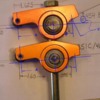John H,
Aftermarket rocker arms fall into two categories; (1) those that mount on studs and are laterally positioned by their push rods using guide plates, (2) those that are mounted rigidly to the cylinder head and are laterally positioned by the orientation of their mounting system. The second type of rocker arm is described by several names: individual shaft mount, pedestal mount, saddle mount, or bolt down. Whatever they may be called they have two things in common, they mount rigidly to the cylinder head and they are equipped with threaded push-rod cup style adjusters for solid tappet lash adjustment or hydraulic tappet compression adjustment.
Rigidly mounted rocker arms are preferred because they have several advantages in comparison to stud mounted rocker arms: rocker arm geometry is not dependent upon the length of the push rod, rocker arm geometry is not altered during lash adjustment, rocker arm geometry is easier to set because it can be set while the cylinder head is sitting on a work bench, and the mounting system is more stable thus eliminating any rocker arm induced valve train instability problems. T&D rocker arms are supplied with a "Stand Height Gage" to aid in setting rocker arm geometry.
Pressurized oil is supplied to all rocker arms via the pushrod. Most rocker companies have a through hole in the push rod cup or the push rod cup adjuster screw. The through hole allows oil to spray out the top of the cup or the adjuster, the oil hits the valve cover, and then rains down on the rocker arms.
By contrast T&D rocker arms are internally lubricated. Oil supplied by the push rod to the push rod cup adjuster screw makes a 90° turn and enters the rocker body itself. An oil passage within the rocker arm body routes the oil between the two bearings in the rocker and then out to the opposite end of the rocker arm where it sprays against the backside of the roller tip. T&D rocker arms thus have engine oil pressure right to the fulcrum bearings; bearing issues are a rare occurrence with T&D rocker arms.
All aluminum rocker arms will eventually fail from fatigue, even those made from billet aluminum. This is true with anything made of aluminum that cycles. Aluminum rocker arm failure is predominantly a function of cycle time. They cycle faster at high rpm, but even at idle the rocker arms are being cycled. Valve lift has nothing to do with rocker fatigue what so ever. Valve spring force should not be a significant factor since the topic at hand is performance street engines which are generally limited to 400 pounds over the nose (or less) in the name of valve train longevity.
T&D aluminum rocker arms have the highest cycle time in the rocker arm industry ... BUT... T&D rocker arms are also the only rigidly mounted rocker arms which at this time are available optionally with a steel rocker arm body for the best possible longevity. While other rocker arm companies manufacture stud mounted rocker arms made of cast steel, T&D’s steel rocker arm bodies are machined from billet chromoly steel, their cycle time life is almost infinite.
If the T&D rocker arms are outside of a person’s budget I have two other recommendations, both are rigidly mounted billet aluminum rocker arms. If the cylinder heads have already been machined for 7/16 studs and guide plates the Yella Terra YT6321 rocker arms will mount solidly to the machined pedestals in place of the studs and guide plates. Yella Terra sells saddles of varying height to aid in setting the rocker arm's geometry. If the cylinder heads are unmodified, still equipped with slotted rocker arm pedestals, the Scorpion part no. 3224 rocker arms mount to slotted pedestals with 5/16 Allen bolts. Shims are available to aid in setting the rocker arm geometry of pedestal mounted rocker arms such as these.
In terms of stud and guide plate rocker arms ... you're on your own.
In terms of BBC rocker arms, the distance from mounting stud to valve tip is 0.025" greater, and the push rod cup end is 21 degrees askew ...
PANTERA INTERNATIONAL
A DE TOMASO CAR CLUB
Presents the De Tomaso Forums
The On-Line Meeting Place for De Tomaso Owners and Enthusiasts From Around the World
Clicking on the banner will take you to the sponsor's website.


